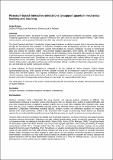Files in this item
Research-based interactive simulations to support quantum mechanics learning and teaching
Item metadata
| dc.contributor.author | Kohnle, Antje | |
| dc.contributor.editor | Fazio, Claudio | |
| dc.contributor.editor | Mineo, Rosa Maria Sperandeo | |
| dc.date.accessioned | 2015-07-08T16:40:01Z | |
| dc.date.available | 2015-07-08T16:40:01Z | |
| dc.date.issued | 2015-06-30 | |
| dc.identifier | 170125342 | |
| dc.identifier | aff95aaf-b0ca-4312-9c2e-2b79a7c77ddd | |
| dc.identifier.citation | Kohnle , A 2015 , Research-based interactive simulations to support quantum mechanics learning and teaching . in C Fazio & R M S Mineo (eds) , Teaching/Learning Physics: Integrating Research into Practice : Proceedings of the GIREP-MPTL 2014 International Conference held in Palermo, Italy, July 7 - 12, 2014 . Università degli Studi di Palermo , Palermo , pp. 29-40 , GIREP-MPTL 2014 International Conference , Palermo , Italy , 7/07/14 . | en |
| dc.identifier.citation | conference | en |
| dc.identifier.isbn | 978-88-907460-7-9 | |
| dc.identifier.other | ORCID: /0000-0003-2638-4826/work/27138989 | |
| dc.identifier.uri | https://hdl.handle.net/10023/6940 | |
| dc.description.abstract | Quantum mechanics holds a fascination for many students, but its mathematical complexity can present a major barrier. Traditional approaches to introductory quantum mechanics have been found to decrease student interest. Topics which enthuse students such as quantum information are often only covered in advanced courses. The QuVis Quantum Mechanics Visualization project (www.st-andrews.ac.uk/physics/quvis) aims to overcome these issues through the development and evaluation of interactive simulations with accompanying activities for the learning and teaching of quantum mechanics. Simulations support model-building by reducing complexity, focusing on fundamental ideas and making the invisible visible. They promote engaged exploration, sense-making and linking of multiple representations, and include high levels of interactivity and direct feedback. Some simulations allow students to collect data to see how quantum-mechanical quantities are determined experimentally. Through text explanations, simulations aim to be self-contained instructional tools. Simulations are research-based, and evaluation with students informs all stages of the development process. Simulations and activities are iteratively refined using individual student observation sessions, where students freely explore a simulation and then work on the associated activity, as well as in-class trials using student surveys, pre- and post-tests and student responses to activities. A recent collection of QuVis simulations is embedded in the UK Institute of Physics Quantum Physics website (quantumphysics.iop.org), which consists of freely available resources for an introductory course in quantum mechanics starting from two-level systems. This approach immediately immerses students in quantum phenomena that have no classical analogue, using simpler mathematical tools that allow a greater focus on conceptual understanding. It allows from the start a discussion of interpretative aspects of quantum mechanics and quantum information theory. This article gives an overview of the QuVis resource and describes the development and iterative refinement process based on student feedback. | |
| dc.format.extent | 981491 | |
| dc.language.iso | eng | |
| dc.publisher | Università degli Studi di Palermo | |
| dc.relation.ispartof | Teaching/Learning Physics: Integrating Research into Practice | en |
| dc.subject | Quantum mechanics | en |
| dc.subject | Computer simulations | en |
| dc.subject | Conceptual understanding | en |
| dc.subject | QC Physics | en |
| dc.subject | NDAS | en |
| dc.subject.lcc | QC | en |
| dc.title | Research-based interactive simulations to support quantum mechanics learning and teaching | en |
| dc.type | Conference item | en |
| dc.contributor.institution | University of St Andrews. School of Physics and Astronomy | en |
| dc.contributor.institution | University of St Andrews. Centre for Higher Education Research | en |
| dc.identifier.url | http://www1.unipa.it/girep2014/item6.html | en |
| dc.identifier.url | http://www1.unipa.it/girep2014/proceedings/Chapter%201.pdf | en |
This item appears in the following Collection(s)
Items in the St Andrews Research Repository are protected by copyright, with all rights reserved, unless otherwise indicated.

